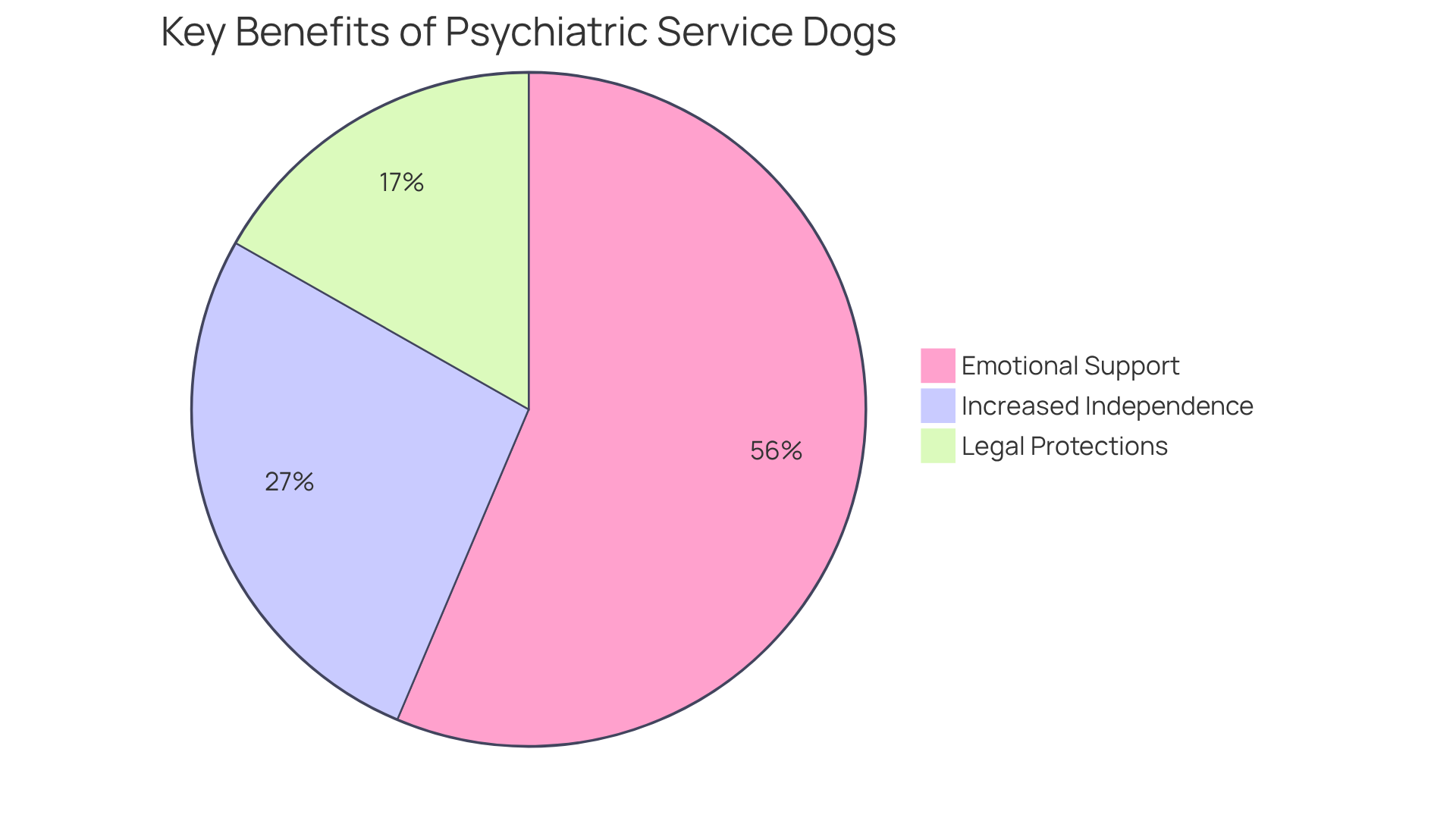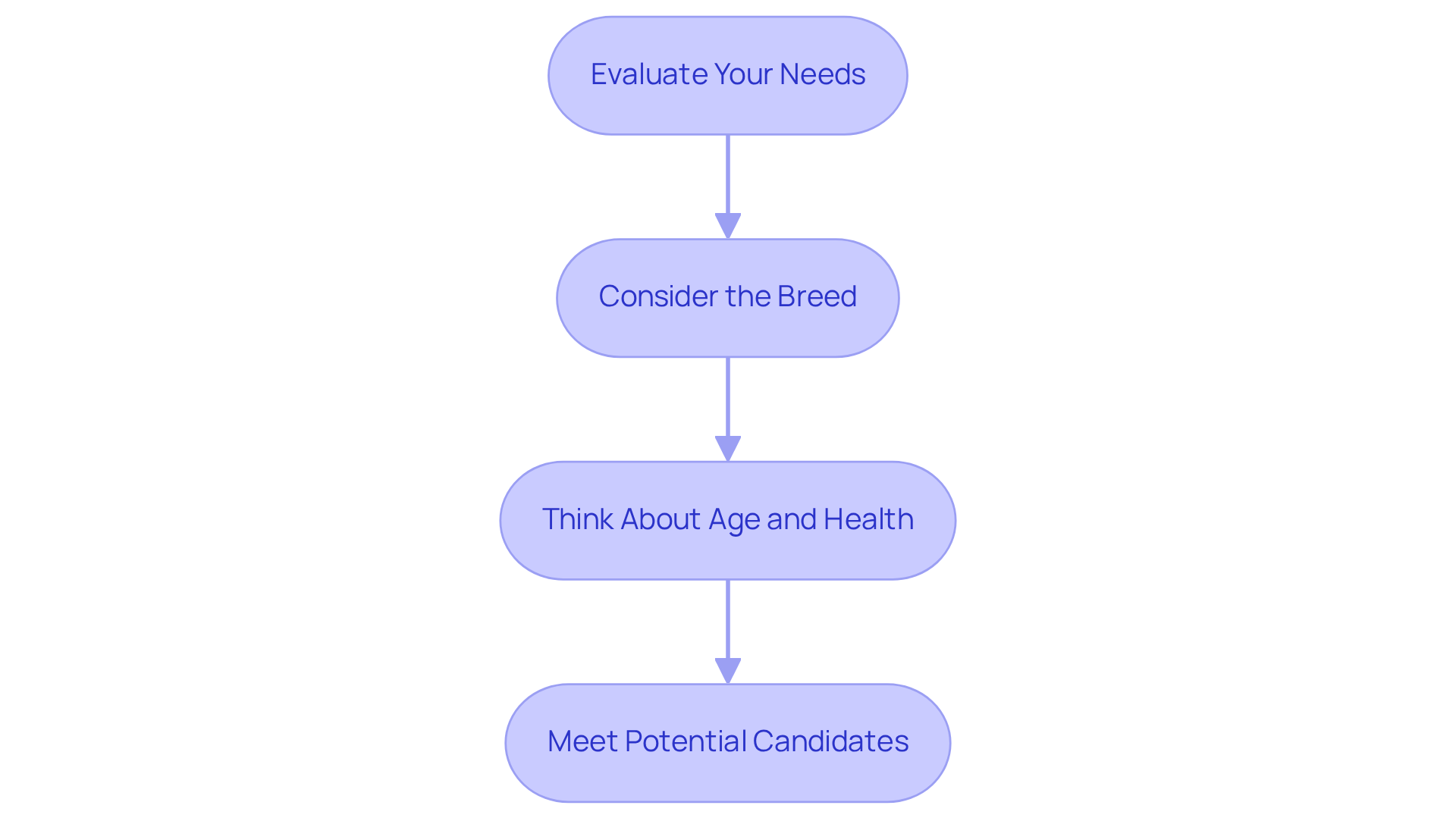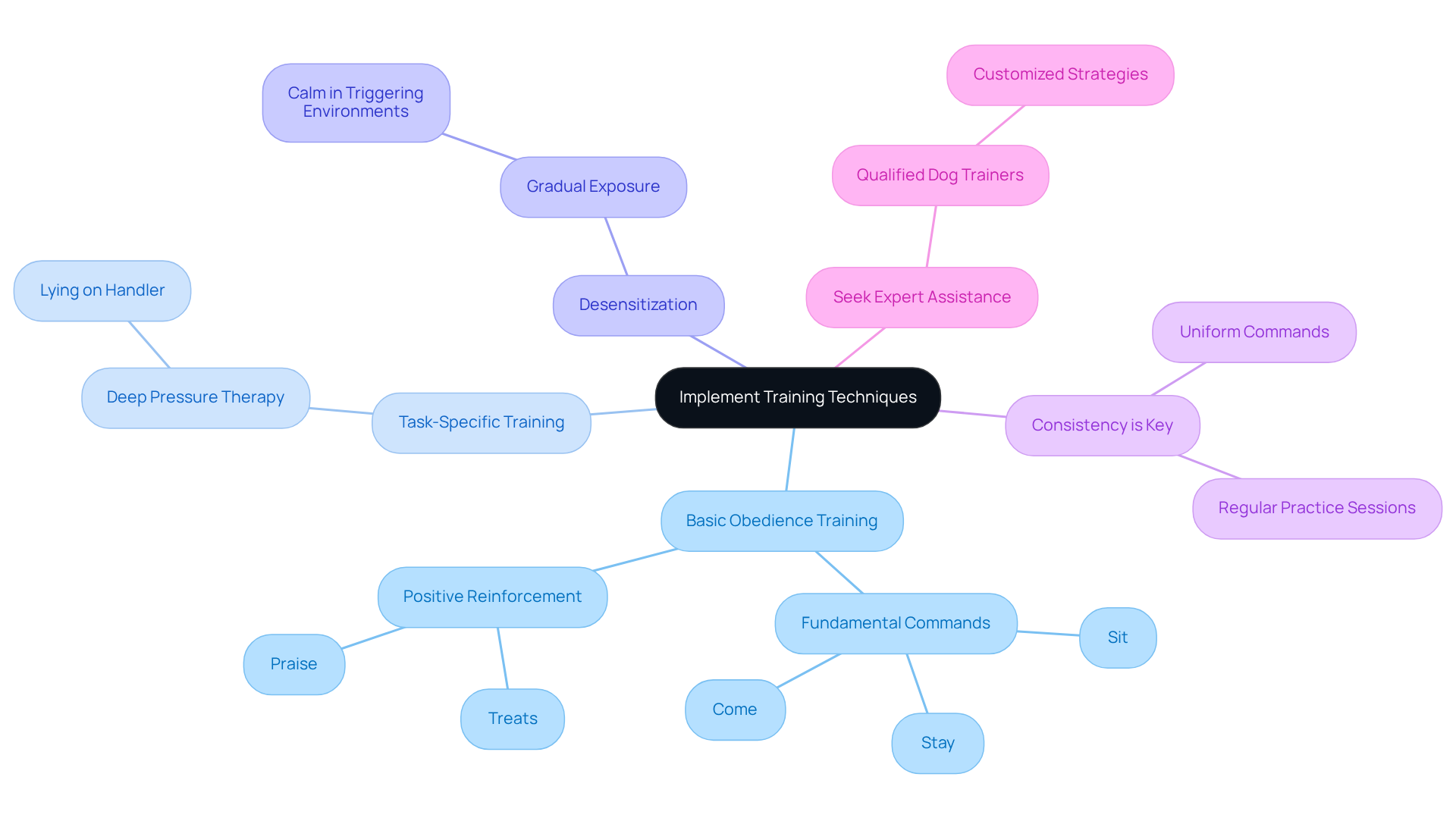

4 Steps for Effective PSD Service Dog Training
by Lena Park
Last updated: July 6, 2025
Verified and Approved by:
Angela Morris,
MSW, LCSW
Fact Checked

Overview
The article highlights four essential steps for effective psychiatric service dog (PSD) training. It begins by acknowledging the emotional challenges faced by individuals with mental health conditions, emphasizing the significant role that PSDs can play in providing support.
- The first step involves understanding the vital roles that PSDs fulfill, which can include offering emotional support and fostering independence.
- Next, it discusses the importance of preparing for training by selecting the right dog, ensuring a perfect match for the individual’s unique needs.
- The third step focuses on implementing training techniques that are tailored to the specific requirements of the handler, fostering a deeper bond and understanding.
- Finally, the article stresses the necessity of maintaining ongoing training, which nurtures the relationship between the PSD and the handler over time.
Each step is supported by evidence of the profound benefits PSDs provide, reinforcing the idea that a compassionate, personalized approach to training is crucial for those navigating their mental health journey.
Introduction
Psychiatric service dogs (PSDs) are more than just companions; they are trained allies that play a crucial role in enhancing the well-being of individuals facing mental health challenges. These remarkable animals provide essential support, from offering emotional comfort to performing specific tasks that can significantly improve daily life. However, the journey to effectively harnessing the benefits of a PSD begins with understanding the training process, which can often seem daunting. How can individuals ensure their service dogs are equipped to meet their unique needs while fostering a strong bond that enhances both their lives?
Many individuals struggle with emotional challenges that can feel overwhelming. The presence of a psychiatric service dog can offer profound relief, providing not only companionship but also a sense of security and stability. Imagine having a loyal friend by your side, one that can help navigate the complexities of daily life. This relationship is built on trust and understanding, which can significantly alleviate feelings of anxiety and isolation.
As we explore the training process for PSDs, it is important to remember the emotional journey involved. Each step taken toward training is a step toward empowerment, not just for the dog but for the individual as well. By investing time and effort into this process, individuals can create a strong bond that enhances their lives. Together, they can face challenges with renewed strength and confidence.
In this journey, support is available. Understanding the training process is key, and it opens the door to a world of possibilities where both the individual and the service dog thrive. It’s a partnership that nurtures growth and healing, ultimately leading to a more fulfilling life.
Understand the Role and Benefits of Psychiatric Service Dogs
Psychiatric service animals (PSDs) are carefully trained companions who assist individuals navigating the complexities of mental health conditions, playing an essential role in their daily lives. These remarkable dogs perform vital functions such as providing deep pressure therapy during anxiety episodes, reminding their handlers to take medications, and interrupting self-harming behaviors. Grasping these roles is crucial for effective PSD service dog training and maximizing the benefits of having a PSD. Let’s explore some key advantages:
- Emotional Support: PSDs offer a sense of companionship that can significantly ease feelings of loneliness and anxiety. Research reveals that 84% of PTSD patients paired with assistance dogs experience substantial symptom reduction, highlighting the profound emotional impact these animals have. Furthermore, 40% of PTSD patients were able to reduce their medications after being matched with a support dog, underscoring the significant benefits these animals provide.
- Increased Independence: With a PSD by their side, individuals often feel empowered to engage in daily activities they might otherwise shy away from. This newfound independence can lead to an enhanced quality of life and improved social interactions, particularly for working professionals managing stress related to their jobs.
- Legal Protections: Under the Americans with Disabilities Act (ADA), PSDs are recognized as support animals, affording their handlers access to public spaces and housing that may otherwise restrict pets. Additionally, the Fair Housing Act stipulates that landlords cannot impose special fees or deposits for assistance dogs, offering essential legal protections for individuals facing housing challenges due to their mental health conditions.
The bond between a handler and their dog is profound, and proper PSD service dog training is essential to ensure that the dog can fulfill its important duties. Mental health experts emphasize the importance of PSD service dog training, as it not only enhances the dog’s ability to assist but also strengthens the connection between the handler and their service dog. As Dr. Jeremy Barron poignantly states, “Caring for a pet provides a sense of purpose to the owner,” highlighting the transformative role that PSDs play in managing mental health challenges. By recognizing these advantages and the importance of proper preparation, individuals can truly appreciate the positive influence of PSDs in their lives.

Prepare for Training: Assess Needs and Choose the Right Dog
Before beginning your preparation, it’s essential to thoughtfully assess your unique needs and choose a dog that resonates with those requirements. Here’s how to navigate this important decision:
-
First, take a moment to evaluate your needs. What specific tasks do you envision your dog performing as part of the psd service dog training? Whether it’s alerting you to anxiety triggers or providing comfort during stressful moments, understanding these needs is crucial for effective psd service dog training.
-
Next, consider the breed. Some breeds are naturally more suited for assistance tasks due to their disposition and trainability. Breeds like Labrador Retrievers, Golden Retrievers, and German Shepherds are often recommended for their intelligence and friendly nature, making them wonderful companions for psychiatric support.
-
It’s also important to think about age and health. A younger dog may bring the energy and adaptability necessary for training, while an older dog might offer the calm demeanor that is essential for service work. Ensure that the dog you choose is healthy and free from behavioral issues that could hinder learning.
-
Finally, spend time meeting potential candidates. Observe their temperament and how well they connect with you. Look for a dog that shows calmness, attentiveness, and responsiveness to commands—these qualities are vital for a successful partnership.
By thoughtfully selecting the right dog, you lay a strong foundation for effective psd service dog training, which ultimately enhances the support your PSD can provide.

Implement Training Techniques: Teach Essential Skills and Tasks
PSD service dog training is a vital step in effectively managing your mental health. It’s understandable to feel overwhelmed, but with the right techniques, you can ensure your dog learns the essential skills to support you.
Basic Obedience Training: Start with fundamental commands such as sit, stay, and come. Using positive reinforcement, like treats and praise, can motivate your dog and encourage the behaviors you want to see. This foundational training builds trust and connection between you and your dog.
Task-Specific Training: Once your dog has mastered basic commands, you can shift your focus to specific tasks tailored to your needs. For example, if your dog is meant to provide deep pressure therapy, practice having them lie on you during anxiety episodes. A survey by The Zebra found that 46.9% of respondents feel that having a pet enhances their mental well-being, highlighting the importance of proper guidance for PSDs.
Desensitization: It’s crucial to gradually introduce your dog to environments and situations that may trigger your anxiety. This process helps them learn to remain calm and focused, providing effective support in real-world scenarios. Think of it as a journey you embark on together, fostering resilience in both of you.
Consistency is Key: Maintaining uniformity in commands and rewards is essential to prevent confusion. Regular practice sessions strengthen learning and create a solid bond between you and your dog. Remember, consistency nurtures trust and understanding.
Seek Expert Assistance: If you encounter challenges, consider reaching out to a qualified dog trainer who specializes in assistance dog education. As a professional instructor noted, “Task-oriented preparation is crucial for ensuring that assistance dogs can effectively support their handlers in managing their conditions.” Their expertise can provide you with customized strategies that enhance your training efforts.
By applying these techniques in your PSD service dog training, you can successfully train your PSD to perform essential tasks that contribute to your emotional well-being, ultimately improving your quality of life. For those seeking additional support, Wellness Wag offers ESA letters that can facilitate access to housing and travel accommodations, further enhancing the benefits of having a trained PSD. Remember, you are not alone on this journey; support is available to help you thrive.

Maintain Training: Ensure Consistency and Adapt to Changing Needs
Training does not conclude once your dog has mastered essential skills; ongoing maintenance is vital for ensuring the effectiveness of PSD service dog training in their role. Here’s how to maintain training:
-
Regular practice sessions are important. Arrange consistent practice times to strengthen acquired behaviors and introduce new tasks as needed. This regularity not only enhances their preparation but also improves their reliability, providing you with the support you need.
-
Monitoring progress is crucial. Keep a close eye on your dog’s performance and any shifts in your needs. If particular tasks become less effective, don’t hesitate to modify the instruction to better fit your current situation. This adaptability can make a significant difference in your daily life.
-
Staying engaged with your dog is essential. Engage through play and bonding activities. A strong relationship fosters responsiveness and trust, which are crucial for effective assistance. Reflect on how your connection with your dog can enhance their ability to support you.
-
As your mental health needs evolve, be prepared to adjust your dog’s instruction. This may involve teaching new tasks or refining existing ones to ensure they continue to meet your requirements. Remember, flexibility is key in this journey together.
-
Seeking support is never a sign of weakness. Consult trainers or support groups for guidance on maintaining your regimen and addressing any challenges you encounter. You are not alone in this; there are resources available to help you navigate your path.
-
Furthermore, honoring the working status of assistance dogs is crucial for effective preparation. Avoid distracting or petting them without permission from their handlers, as this can interfere with their tasks and compromise the safety and well-being of the handler. Understanding the breeds frequently preferred for assistance tasks, such as Labrador Retrievers, Golden Retrievers, German Shepherds, and Poodles, can also guide your instructional method, as these breeds are often chosen for their intelligence, trainability, and temperament.
-
Continuous education is essential. Statistics show that 50-70% of assistance dog candidates do not finish their instruction due to various challenges. This underscores the importance of consistent practice and adaptation in your PSD service dog training to ensure your dog can effectively support you. By prioritizing ongoing training and flexibility, while respecting the working status of your service dog, you can enhance the quality of life for both you and your service dog.

Conclusion
Psychiatric service dogs (PSDs) are not just companions; they are invaluable allies for individuals navigating the complexities of mental health challenges. They offer emotional support, foster independence, and provide essential legal protections. Understanding the significant roles these dogs play is crucial for effective training, which not only enhances their ability to assist but also deepens the bond between handler and dog. Recognizing the profound impact of PSDs allows individuals to appreciate the transformative benefits they bring to daily life.
The journey to effective PSD service dog training can feel overwhelming, but it begins with a thoughtful assessment of personal needs and the selection of the right dog. From there, targeted training techniques focusing on essential skills and tasks are implemented. Regular maintenance of training is vital; it ensures that the dog remains effective and responsive to the handler’s evolving needs. Consistency, adaptability, and seeking expert guidance are key elements that contribute significantly to the success of the training process. Have you considered how these factors can shape your experience with a PSD?
Ultimately, the role of psychiatric service dogs extends far beyond mere companionship; they are partners in navigating the intricate landscape of mental health. As you embark on this training journey, embracing the support and resources available can lead to a more fulfilling and empowered life. The commitment to ongoing training and adaptation not only enhances the effectiveness of PSDs but also enriches the bond shared with them. This journey paves the way for a brighter future, filled with hope and connection. How might your life change with the support of a PSD by your side?
Frequently Asked Questions
What are psychiatric service dogs (PSDs)?
Psychiatric service dogs (PSDs) are specially trained companions that assist individuals with mental health conditions, providing support in daily life by performing essential tasks such as deep pressure therapy, medication reminders, and interrupting self-harming behaviors.
What emotional benefits do psychiatric service dogs provide?
PSDs offer companionship that helps reduce feelings of loneliness and anxiety. Research indicates that 84% of PTSD patients paired with assistance dogs experience significant symptom reduction, and 40% of these patients can reduce their medications after being matched with a support dog.
How do psychiatric service dogs increase independence for their handlers?
With a PSD, individuals often feel more empowered to engage in daily activities they might otherwise avoid, leading to an improved quality of life and better social interactions, especially for those managing work-related stress.
What legal protections do psychiatric service dogs have?
Under the Americans with Disabilities Act (ADA), PSDs are recognized as support animals, granting their handlers access to public spaces and housing that may otherwise restrict pets. The Fair Housing Act also prohibits landlords from charging special fees or deposits for assistance dogs.
Why is proper training important for psychiatric service dogs?
Proper training is crucial for PSDs to effectively assist their handlers and fulfill their important duties. It also strengthens the bond between the handler and the service dog, enhancing the overall support provided.
What impact do psychiatric service dogs have on mental health management?
PSDs play a transformative role in managing mental health challenges by providing emotional support, increasing independence, and fostering a sense of purpose for their handlers, as highlighted by mental health experts.
Certify Your Emotional Support Animal Today

Why You Can Rely on Us?
At Wellness Wag, we believe your pet deserves care rooted in both science and compassion. Each article is carefully researched, written in clear language for pet owners, and then reviewed by qualified professionals to ensure the information is evidence-based, current, and practical for real-life care. Our goal is to help you feel confident in making informed decisions about your pet’s health and well-being.
Reviewed by
Angela Morris, MSW, LCSW
Angela is a licensed clinical social worker with 20 years of experience in patient advocacy and community mental health. She has assisted numerous clients with ESA evaluations and brings a deep understanding of disability accommodations, ensuring that all information is accurate, supportive, and practical.

Written by :
Lena Park
Last Updated :
July 6, 2025












